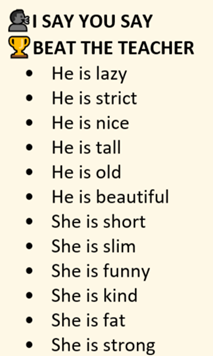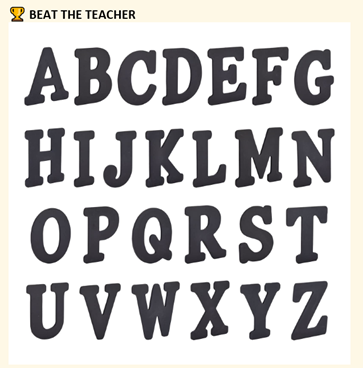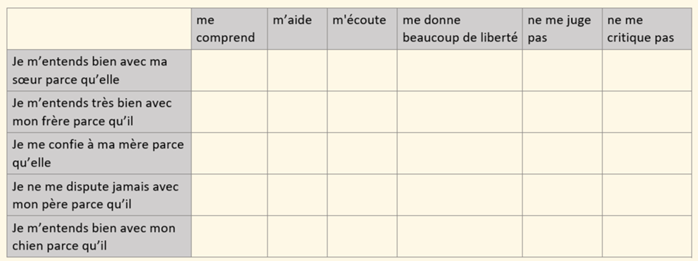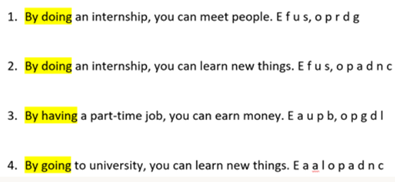I saw a post the other day in one of the MFL Facebook groups about how to liven up ‘choral repetition’ or other activities to help students process language orally, so I’ve compiled some of the ones that have worked best for me so far.
We know from Second Language Acquisition research that doing reading/writing tasks is not enough to acquire new vocabulary and structures to a point where they can be deployed proficiently – see image below.
I’ve also found that students often really enjoy practising language through speech and it’s great for building confidence and helping new language stick.
The activities on this post are loosely sorted into the categories below, depending on the purpose they serve:
- Introducing new vocab
- Structured production
- Wrapping up a lesson or topic
Introducing new vocab
Although I think choral repetition can be done very well, it doesn’t always work for everyone, so here are some alternatives. Some work best for practising language in shorter chunks whilst others help construct longer sentences with new language.
Simon says / Jacques a dit / Simón dice
- For younger students, this is a nice way to liven up introducing new language. Can be done with a set of powerpoint flashcards or Quizlet flashcards. I’d show the English side of the flashcard first, then show the TL and say it aloud, either with or without Simon says at the start, as per the rules of the game!
- To keep students on their toes, every few slides you can go back and do a bit of recall, going back a few slides and challenging students to recall the TL for the English phrase / image on the screen.
I say you say + I say you translate
- This is pure choral repetition, so I only do it as a very quick activity, fast-paced, and with a bit of variety thrown in by doing different intonations / voices / volume.
- If you do it from a sentence builder or parallel vocab list, pointing at each item as you say it, you can then follow up with ‘I say you translate’, where you then point and call out the English and they respond all together with the TL.
- I’ll be honest, I haven’t quite managed to get the super-snappy pace with this yet, the way that I picture them doing it in MFL lessons at the Michaela school. Katie Lockett demonstrated this impressively at a CPD session she did a few years ago on using Knowledge Organisers that did a lot of these activities, so she’s a great person to speak to about this as I believe it’s a staple of her teaching sequence with every topic.
Beat the teacher
- I honestly love this one, and even have some Year 11 classes of competitive students that can enjoy it, but generally it works better with younger ones.
- After introducing a load of new language with a sentence builder / matching sheet / other knowledge organiser, show students either a set of images, or a short list of phrases in English – I normally do about 12, but they can’t be too long otherwise it doesn’t work quite as well. If we’ve just done a matching sheet then I just take a screenshot of the English column and use that.
- You point at one of the images/English phrases (option here to also read it aloud in English) and then you slowly say the French aloud. Students repeat. However, sometimes you will ‘get it wrong’ and say the French for a different phrase, so if you get it wrong, students must NOT repeat it or you get a point, so the aim for you is to ‘trick’ them, and for them not to be tricked!
- You can find an example here of how it works with pictures
- See image below for how I play it with phrases (after doing I say you say), and an example of how I played it after introducing the alphabet, pointing at a letter and then saying it aloud in French or a different letter.


Disappearing text / parallel vocab list
- All you need is a fairly short parallel list of key chunks of language for this satisfying memory game eg. a printout list of chunks from your Quizlet / a two-column list on a page. English on the left and TL on the right.
- This can also be done with longer sentences rather than just chunks – a good opportunity to ‘flood’ the sentences with repeated examples of the target grammatical structures or phrases.
- Display them on the screen, and students have to read each line aloud. They could take turns in pairs or do it chorally.
- Then I freeze the screen and blank out a load of words from the TL side. My basic method is using the black highlighter on word or change text colour to the colour of your page so the words disappear, but if it’s your thing you can do some fancy powerpoint stuff, that would take me far too long…
- Students then reattempt reading each line aloud to try and remember the missing words.
- Continue the steps above until you barely have any of the text left.
Os and Xs / Connect 4
- See image below – students have one or two 3×3 grids to play a couple of games.
- I have two variations of this:
1. Create a sentence from the language provided – as per image below – this lesson was to teach opinions on food, and food items had been introduced in the previous lesson, so students had to make a sentence aloud using the language seen that lesson, so they could refer to the list on the left or sentence builder. Eg. J’adore la cuisine indienne car c’est très savoureux’. To stretch, you can encourage them to build a longer sentence by not limiting themselves to the language on the page, but incorporating other language they know.
2. Translation – give short phrases or chunks in English and students have to translate into TL using sentence builder / vocab list for support – see image below where I used a sentence builder with no L1 translation, so this had to be done at a stage in the teaching sequence where students already had good receptive knowledge of the language so they could find the phrases they needed. - Older students sometimes find Os and Xs a bit futile (‘but you can never win, Miss, it’s always a draw!) so you could try this as Connect 4 / Four in a row with a larger grid.


Reading aloud battleships
- Battleships has always been a classic for MFL. Steve Smith does some good ones on Frenchteacher.net and Esmeralda Salgado of MFLCraft got me really into the different variations of battleships you can do.
- Below is an example where students just create sentences by reading aloud to guess a square.

Survey with sentence builder
- Really simple to prepare – you can either make a survey grid for students or they can just do their own on MWBs.
- They go round the room with their MWBs and sentence builder or refer to it on the board, and ask each other a set of questions, filling out the other person’s answers in L1 on their MWBs, so they are actively listening and translating as well as speaking.
Oral sentence unjumbling with L1
- Have the English sentence on the left, and on the right have the ‘jumbled’ sentence, which you can make quickly using this site
Oral jigsaw translation
- A variation on the above – do this task at a stage where students already have good recognition of the TL terms as it involves them basically matching English to TL orally.
- Students translate a set of English translations aloud in pairs, finding the chunks they need from the grid and crossing them off as they go along.
- See examples below, one has slightly shorter bits so is a lot more challenging. To make it easier, use a grid with fewer cells and longer sentence chunks.


Conti’s sentence stealer
- One of Conti’s very well-known, popular games.
- Good for younger learners although can work well for competitive students at KS4 level too, and is a nice activity to follow a focus on pronunciation
- Explanation here
- Variations:
- My Head of Department does a more challenging version of this activity that I’ve used successfully where you display the sentences on the board in English rather than TL. Students translate into TL on their three cards, and then go round with their SB and instead of reading a sentence aloud off the board, they have to translate the sentence they’d like to guess into TL using their sentence builder.
- Esmeralda Salgado does some great variations here
Trapdoor
- Another MFL classic for younger learners, here’s an explanation from MorganMFL
- There are a lot of free trapdoor tasks already made on different topics that you can get free on TES.
- The text can also be exploited in other ways before and after doing the Trapdoor task, so a large chunk of the lesson can be built around it.
Quiz quiz trade with sentence builder support
- Give all students the same number of cards, anything between 1-3 works well. Display a list of numbered sentences on the board in English, and assign numbers to each pupil – they have to copy down their sentences on one side of the card, and then translate into TL on the other side using their sentence builder.
- When they’ve all prepared their card, they get up and ‘quiz’ other class members on one of their cards by reading them the English, and the classmate has to translate orally into TL using their sentence builder for support. Once both students have quizzed each other, they ‘trade’ cards and go to find a new partner. This allows them to get lots of practice listening and speaking over several different sentences.
Structured production
This refers to the stage in Conti’s E.P.I sequence where students have had plenty of practice through listening and reading and are now starting to produce the language from English into TL in scaffolded ways.
Speaking battleships / translation battleships
- Two of my favourite options:
1. Translate: Provide L1 sentence halves in the boxes for students to translate in order to guess a cell – similar to the ones in ‘reading aloud’ battleships but this time it’s L1 to L2. Sentence Builder or vocab lists could be provided for support.
2. Build sentences: Students have to build a sentence using chunks of L2 or L1 language provided, so they have to think of a sentence to create that incorporates those phrases eg. the left column could contain different time phrases, and the top row could be key verb phrases in the je form or other key phrases for the current topic, and students build the rest of the sentence. Esmeralda Salgado does a great blog here walking through a good example of how you could do this, this one also involves some manipulation as the verbs have to be conjugated on the spot
Oral translation ping pong
- A competitive translation task championed by Conti.
- Can be scaffolded with sentence builders / equivalent knowledge organiser support
- Chris Pye provides an amazing ‘ping pongalizer’ excel template for creating oral ping pong sheets efficiently!
Oral translation race / translation ‘ladders’
- A competitive oral translation game for three players, two players and one referee with the answer sheet. Here is an example you can download and adapt from my TES as it can be used for 1 pen 1 dice, too.
- The players should only be given the English columns, no TL.
- The aim is to translate into TL, with the referee letting them know after each one if they got it correct. It works like trapdoor in that if they translate it correctly, they get another go, but if they make a mistake, they ‘fall’ to the bottom of the ladder and have to start all over again, and it’s the other player’s turn (I’m fairly sure I took this aspect of the game from MorganMFL’s great book)
- The first person to get to the top of the ladder having translated all the phrases wins. A bit like Conti’s ‘pyramid translation’, the great thing is that students get loads of repetition every time they go back to the start.
Quiz quiz trade with reduced support
- Same as Quiz Quiz Trade described above, but this time no sentence builder – it’s pure retrieval practice, but with the great reinforcement that comes from the ‘trade’ aspect of the game – pupils will still get to practise the ones they get wrong or can’t fully recall.
- You could always display the sentences on the board with the first letters of each word in the TL translation if you still think they need a bit of support.
First-letter oral translation
- Provide L1 sentences to translate into L2. For each one, give the first letter of each word in the L2 sentence to help reinforce the correct word order and jog memory.
- Good old Textivate can do this for you, or do it manually like the one below:

Wrapping up a lesson or topic
Bob Up
- The fast pace and competition of this game often prove motivational for students. A fun way to end a lesson and sum up core chunks of language.
- This activity comes from Jake Hunton’s Fun Learning Activities for MFL book but found a good description on this blog
“Split the class down the middle and give students on each side a number or letter so there is a student on either side with the same number/letter. Ask for a translation of a word or sentence and then shout out a number/letter. The first student to shout out correctly wins a point for their team.” - A couple of limitations – this works best with shorter chunks of language rather than sentences. Some students might also find the competition against one other individual a bit intense – it can be awkward when you get rather unbalanced opponents in terms of ability, so may require adapting and using your judgement etc.
Blockbusters or connect 4 team game
- Download a powerpoint blockbusters template – there are some good free ones online. You can also play connect 4 online I believe, or you can use a retro computer program.
- Class is split into two teams, and you read out a short phrase or sentence to translate into TL, followed by silent thinking time for all students. Then you cold call, selecting one pupil from a team to give their answer, and they win that round for that team if correct, and you play according to the connect 4 or blockbusters rules.
- For support, you could let students use sentence builders for extra support during the think time. You could always introduce a ‘pair share’ stage if you think this would be beneficial, before calling on an individual pupil, I sometimes do this depending on the class or difficulty of the language.
- Like Bob Up, the big limitation here is that not all students are talking, but again, because of the pressure of potentially being called upon, they should all be thinking and translating in their heads.
Other activities to explore…
I don’t do the following quite as much as I’ve not had as many successful experiences of them yet, but I’d definitely like to go back to them sometime soon – if you google ‘the language gym’ followed by one of the items below, you’ll probably find a good explanation from Conti’s blog.
- Mind-reader (teacher-led then pupil-led)
- Find someone who
- Pyramid translation
- Dictogloss
- No snakes no ladders
- Oral translation with a game: Esmeralda Salgado is the queen of interactive game templates and online tools for gamifying your speaking tasks – here is the excellent blog again.

